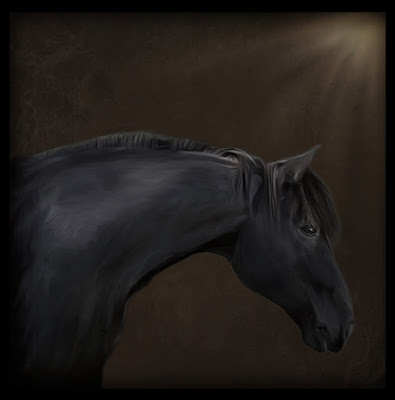Just stumbled across this old post, and thought I'd repost it for the memories!
(Originally published Oct. 19,2009)
Yeah, this weather is really crummy! I must say, I was very proud of myself for venturing out riding yesterday.
The vet came out and looked at Magnum... she did flexion tests, felt his legs, watched him on the lunge, etc. and said she doesn't think it's arthritis. He trotted out sound after the flexions, and she said that should have shown something if it was. After watching him a bit, she did notice how he at times seemed stiff behind and took short steps, but she thinks it's more muscle development, and he's being protective of himself because he's worried about slipping. She had him stand square and looked at him behind, and then showed me, and it's clear that aside from lacking muscle along the top of his hindquarters, his right hind is much more underdeveloped in a couple places. She agreed it was probably from the EPM, that he permanently lost some muscle and it will just take more work to get it back. I asked about the possibility of steroids to help with the development, and she said we could try it down the road if a conditioning program isn't sufficient, but it can make a horse really aggressive.
I had Magnum and Teddy in the front field while waiting for the vet, and Teddy was clearly wanting to play, running around and bucking, and then closely examining each part of Magnum that the vet had just checked. (She'd feel his stifle, Teddy would look at her then closely sniff Magnum's stifle, she'd poke around his pasterns, Teddy would sniff his pasterns, etc. I had to keep shooing him away). So I decided I'd bring Teddy along when I took Magnum for a ride up and down the power lines. Since it was a rainy Friday, I didn't think we'd come across too many other people.
I ponied Teddy until we were across the stream (he likes to walk with his head glued to Magnum's butt, so it wasn't difficult). Then I took off the lead rope and let him run along. Occasionally he'd take a parallel trail, but then he'd always cut across to come back behind us. It was really funny when we got to the open field. Teddy first trotted over to examine the orange traffic cone in the field, then turned and galloped all around, bucking and kicking. Zoey would chase him for a bit, then he'd chase her. It was like having 2 dogs out. If he started to run too far off, I'd call him and he'd come right back.
I think he got a lot more exercise than Magnum, because he chose to run and buck so much. I thought it would also be a good way for him to learn to navigate different terrain without a rider. The only problem was when we turned to come back. Teddy decided to take the lead, and thought he knew the way home, so went galloping full speed up over the hill toward the traffic circle, whinnying the whole time. Magnum got VERY upset at that... he bucked a few times because he wanted to go with Teddy, then pranced the rest of the way with his head straight up. He called to Teddy a few times, but no response.
Turns out, Teddy thought he knew the way back but got lost... he was over by the pavilion, galloping back and forth along the wood line, trying to find the trail. So when we came up over the hill, he saw Magnum and came straight back to us, with his head at Magnum's butt as usual. I thought he might have learned his lesson about running off, but once we got down to the main open field, he figured NOW he knew the way back and took off again. Unfortunately, this time he followed the road up to the playground area. (So much for horses having great sense of direction). So we walked up there, and he was again galloping along the wood line, whinnying and trying to find the trail. Magnum and I just stood there until Teddy saw we weren't going to follow him and came dejectedly back to us. Then he obediently followed the rest of the way home. I think he was quite tired by then... he hasn't had that kind of a workout before. It was a fun experiment. I'd like to do it again, but a weekend probably isn't the best time.












